In mathematics, functions are fundamental tools that describe relationships between inputs and outputs. Understanding the domain and range of a function is crucial for grasping its behavior and applications. Just like a vending machine accepts specific coins (domain) to dispense certain drinks (range), a function operates on a defined set of input values to produce corresponding output values.
This guide will provide a detailed exploration of how to find the domain and range of various functions. We’ll cover the definitions, rules, and techniques necessary to master these essential concepts, ensuring you have a solid understanding for your mathematical journey.
What are Domain and Range?
In mathematics, when we talk about relations and functions, domain and range are fundamental concepts that define the scope of these mathematical objects.
For relations, which are simply sets of ordered pairs, the domain and range are defined as follows:
- Domain: The domain of a relation is the set of all first elements (x-coordinates) from the ordered pairs.
- Range: The range of a relation is the set of all second elements (y-coordinates) from the ordered pairs.
Let’s consider an example to illustrate this. Suppose we have a relation R = {(1, 2), (2, 2), (3, 3), (4, 3)}.
- The domain of R is the set of all x-coordinates: {1, 2, 3, 4}.
- The range of R is the set of all y-coordinates: {2, 3}.
This can be visualized as:
Alt text: Visual representation of domain and range in a relation, showing x-coordinates forming the domain and y-coordinates forming the range from a set of ordered pairs.
The concept of domain and range extends to functions, which are special types of relations where each input is associated with exactly one output.
Domain and Range of a Function
For a function, the domain and range take on a more specific meaning related to the function’s operation:
- Domain of a Function: The domain is the set of all possible input values (often denoted as ‘x’) for which the function is defined. These are the values you are allowed to “input” into the function.
- Range of a Function: The range is the set of all possible output values (often denoted as ‘y’ or f(x)) that the function can produce. These are the values that result from applying the function to the domain.
We can represent this relationship as: Domain → Function → Range. If we have a function f that maps elements from set A to set B, denoted as f: A → B, then A is the domain and B is the codomain. The set of actual outputs within the codomain B is the range.
Consider the function f(x) = 2x. If the domain is specified as the set of natural numbers (N), then:
Alt text: Diagram illustrating domain and range of a function f(x), showing inputs from the domain being transformed by the function to produce outputs in the range.
For the function f(x) = 2x with a domain D = {x ∈ N} (natural numbers), the range R = {y ∈ N: y = 2x} would be the set of even natural numbers.
Domain of a Function: Finding Valid Inputs
The domain of a function is essentially the set of all permissible inputs. It’s about identifying “all the values” that you can feed into a function without causing any mathematical errors or undefined results. In simpler terms, the domain is the set of all possible ‘x’ values for the function.
Think of a function like a machine. The domain is like the slot where you insert input. You need to know what types of inputs the machine accepts. For example, if we consider f(x) = 2x again. If there are no restrictions specified, we generally assume the domain to be all real numbers because you can multiply any real number by 2. So, the domain of f(x) = 2x is (-∞, ∞).
However, certain types of functions have inherent restrictions on their domains. Here are some key rules to find the domain for different function types:
Rules for Finding the Domain of a Function
| Rule | Function Type | Restriction | Example | Domain |
|---|---|---|---|---|
| 1 | Polynomial Function (e.g., f(x) = x² + 3x – 2) | No restrictions | f(x) = x² + 3x – 2 | ℝ (All Real Numbers) or (-∞, ∞) |
| 2 | Square Root Function (e.g., f(x) = √x) | Expression under the square root must be non-negative (≥ 0) | f(x) = √(x – 3) | x – 3 ≥ 0 => x ≥ 3 or [3, ∞) |
| 3 | Rational Function (Fraction) (e.g., f(x) = 1/x) | Denominator cannot be zero | f(x) = 1/(x – 2) | x – 2 ≠ 0 => x ≠ 2 or (-∞, 2) ∪ (2, ∞) |
| 4 | Logarithmic Function (e.g., f(x) = ln(x)) | Argument of the logarithm must be positive (> 0) | f(x) = ln(x + 5) | x + 5 > 0 => x > -5 or (-5, ∞) |
| 5 | Tangent Function (tan(x)) and Secant Function (sec(x)) | Cosine in denominator cannot be zero | f(x) = tan(x) = sin(x)/cos(x) | cos(x) ≠ 0 => x ≠ (2n+1)π/2, where n is an integer |
| 6 | Cotangent Function (cot(x)) and Cosecant Function (csc(x)) | Sine in denominator cannot be zero | f(x) = cot(x) = cos(x)/sin(x) | sin(x) ≠ 0 => x ≠ nπ, where n is an integer |
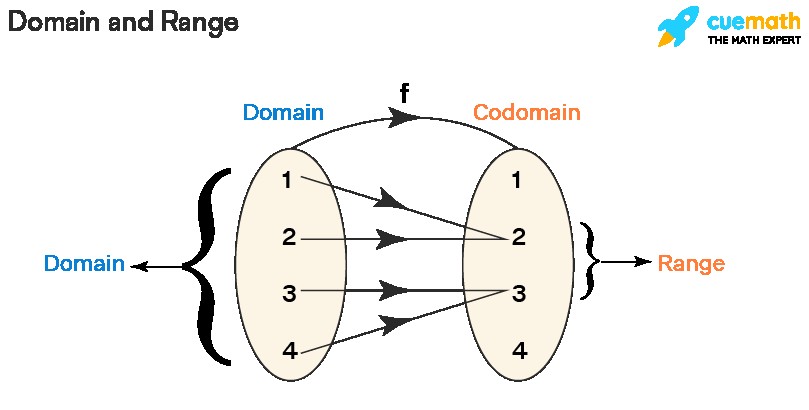
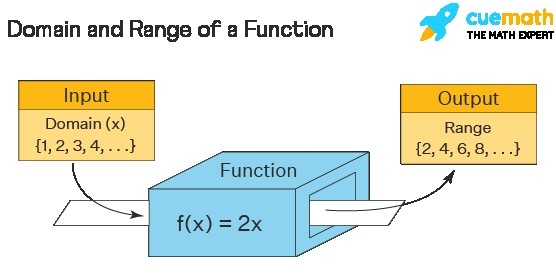
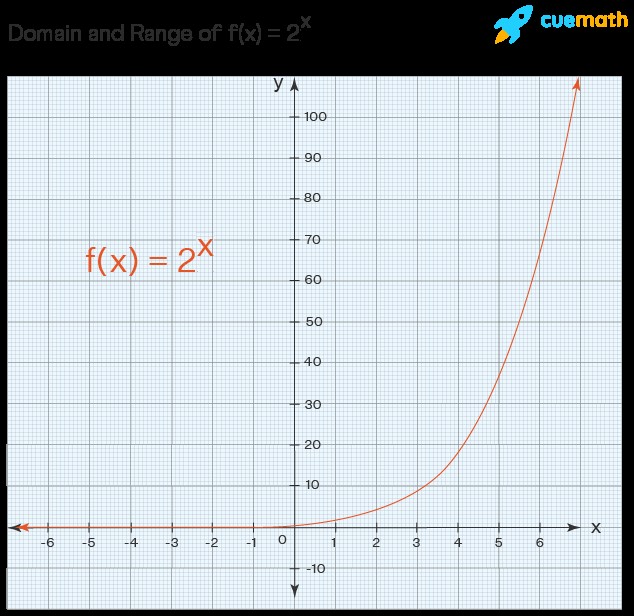
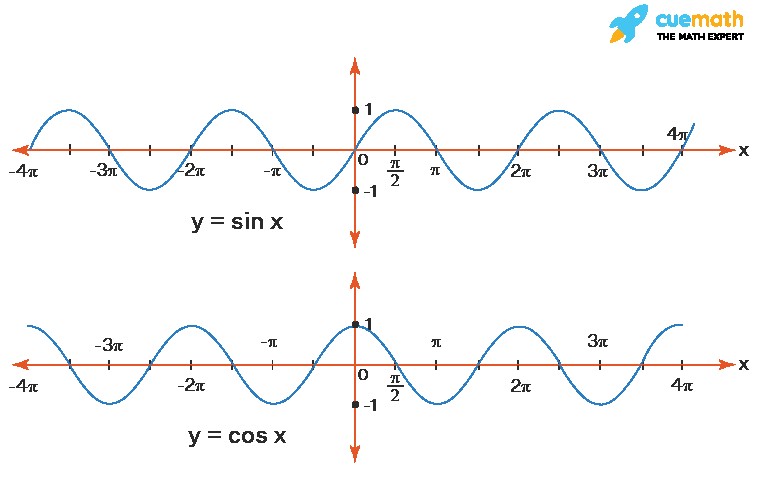
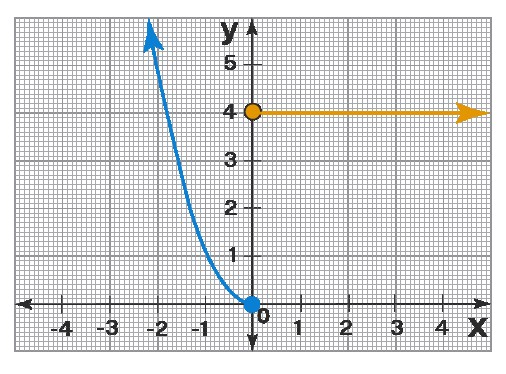

How to Find the Domain of a Function: Examples
Let’s apply these rules with examples:
Example 1: Finding the domain of a square root function
Find the domain of f(x) = √(x + 3).
Using Rule 2, we know that the expression under the square root must be greater than or equal to 0. So, we set up the inequality:
x + 3 ≥ 0
Solving for x:
x ≥ -3
Therefore, the domain of f(x) = √(x + 3) is [-3, ∞).
Example 2: Finding the domain of a rational function
Find the domain of g(x) = (2x + 1) / (x – 2).
Using Rule 3, the denominator cannot be zero. So, we set:
x – 2 ≠ 0
Solving for x:
x ≠ 2
Thus, the domain of g(x) is all real numbers except 2, which is written in interval notation as (-∞, 2) ∪ (2, ∞).
Range of a Function: Finding Possible Outputs
The range of a function is the set of all possible output values. It’s what you get out of the function after you’ve put in all possible valid inputs from the domain. For a function f: A → B, where A is the domain and B is the codomain, the range is the subset of B that consists of all actual outputs.
Determining the range can sometimes be more complex than finding the domain. One of the most effective ways to find the range is to visualize the function’s graph and observe the y-values it covers. However, there are also rules and techniques for common function types:
Rules for Finding the Range of a Function
| Rule | Function Type | Range | Explanation |
|---|---|---|---|
| 1 | Linear Function (f(x) = mx + b, m ≠ 0) | ℝ (All Real Numbers) or (-∞, ∞) | Linear functions with a non-zero slope cover all real numbers. |
| 2 | Quadratic Function (f(x) = a(x – h)² + k, a ≠ 0) | If a > 0: [k, ∞) (y ≥ k); If a < 0: (-∞, k] (y ≤ k) | The vertex (h, k) is the minimum (a > 0) or maximum (a < 0) point. |
| 3 | Square Root Function (f(x) = √x) | [0, ∞) (y ≥ 0) | Square roots always produce non-negative values. |
| 4 | Exponential Function (f(x) = aˣ, a > 0, a ≠ 1) | (0, ∞) (y > 0) | Exponential functions are always positive. |
| 5 | Logarithmic Function (f(x) = logₐ(x), a > 0, a ≠ 1) | ℝ (All Real Numbers) or (-∞, ∞) | Logarithmic functions can produce any real number as output. |
| 6 | Rational Function (y = f(x)) | Solve for x in terms of y, find domain of x = g(y). Range of f(x) is the domain of g(y). | Find the inverse function’s domain to get the original function’s range. |
How to Find the Range of a Function: Examples
Example 1: Finding the range of a quadratic function
Find the range of f(x) = 2(x – 3)² – 5.
This is a quadratic function in vertex form, y = a(x – h)² + k, where a = 2, h = 3, and k = -5. Since a = 2 > 0, the parabola opens upwards, and the vertex (3, -5) is the minimum point. Using Rule 2, the range is y ≥ -5 or [-5, ∞).
Example 2: Finding the range of a logarithmic function
Find the range of g(x) = ln(2x – 3) + 4.
Using Rule 5, the range of a logarithmic function is all real numbers. The addition of 4 and the coefficient of x within the logarithm do not change the fundamental range of the logarithmic function itself. Thus, the range of g(x) is ℝ or (-∞, ∞).
How to Calculate Domain and Range: A Step-by-Step Approach
Let’s illustrate the calculation of domain and range with a specific example using sets.
Suppose X = {1, 2, 3, 4, 5} and Y = {1, 2, 3, 4, 5, 6}. Consider a function f: X → Y defined by the rule y = f(x) = x + 1.
-
Domain: The domain is explicitly given as the set X, which is the set of input values. So, Domain = X = {1, 2, 3, 4, 5}.
-
Range: To find the range, we apply the function f(x) = x + 1 to each element in the domain:
- f(1) = 1 + 1 = 2
- f(2) = 2 + 1 = 3
- f(3) = 3 + 1 = 4
- f(4) = 4 + 1 = 5
- f(5) = 5 + 1 = 6
Thus, the range is the set of output values: {2, 3, 4, 5, 6}.
It’s important to note that Y is the codomain in this case, not the range. The range is the set of actual outputs, which is a subset of the codomain.
Domain and Range of Exponential Functions
Exponential functions are of the form y = aˣ, where a > 0 and a ≠ 1.
- Domain: Exponential functions are defined for all real numbers. You can raise a positive number to any real power. Therefore, the domain of an exponential function is ℝ or (-∞, ∞).
- Range: Exponential functions always produce positive values. No matter what real number you input for x, aˣ will always be greater than 0. Thus, the range of an exponential function is (0, ∞).
Example: Consider f(x) = 2ˣ.
Alt text: Graph of the exponential function y=2^x, illustrating the domain as all real numbers and the range as positive real numbers above the x-axis.
- Domain: ℝ or (-∞, ∞)
- Range: (0, ∞)
Domain and Range of Trigonometric Functions
Trigonometric functions, like sine (sin(x)) and cosine (cos(x)), are periodic functions with specific domain and range characteristics.
- Sine Function (sin(x)) and Cosine Function (cos(x))
- Domain: Both sine and cosine functions are defined for all real numbers. Domain = ℝ or (-∞, ∞).
- Range: The values of both sin(x) and cos(x) oscillate between -1 and 1, inclusive. Range = [-1, 1].
Alt text: Graphs of sine and cosine functions showing their periodic nature, domain extending across all x-values, and range limited between -1 and 1 on the y-axis.
The domain and range for all six basic trigonometric functions are summarized below:
| Trigonometric Function | Domain | Range |
|---|---|---|
| sin(θ) | (-∞, +∞) | [-1, +1] |
| cos(θ) | (-∞, +∞) | [-1, +1] |
| tan(θ) | ℝ – {(2n + 1)π/2 | n ∈ Integers} |
| cot(θ) | ℝ – {nπ | n ∈ Integers} |
| sec(θ) | ℝ – {(2n + 1)π/2 | n ∈ Integers} |
| csc(θ) | ℝ – {nπ | n ∈ Integers} |
Domain and Range of an Absolute Value Function
The absolute value function is given by y = |ax + b|.
- Domain: Absolute value functions are defined for all real numbers. Domain = ℝ or (-∞, ∞).
- Range: The absolute value of any real number is always non-negative (greater than or equal to 0). Therefore, the range of y = |ax + b| is [0, ∞).
Example: Find the domain and range of f(x) = |6 – x|.
- Domain: ℝ or (-∞, ∞)
- Range: [0, ∞)
Domain and Range of a Square Root Function
A square root function is of the form f(x) = √(ax + b).
- Domain: The expression under the square root must be non-negative. So, ax + b ≥ 0. Solving for x gives the domain.
- Range: The principal square root (√) always returns a non-negative value. Thus, the range is [0, ∞).
Example: Calculate the domain and range of h(x) = 2 – √(-3x + 2).
Domain:
-3x + 2 ≥ 0
-3x ≥ -2
x ≤ 2/3
Domain = (-∞, 2/3]
Range:
We know √(-3x + 2) ≥ 0.
-√(-3x + 2) ≤ 0
2 – √(-3x + 2) ≤ 2
y ≤ 2
Range = (-∞, 2]
Finding Domain and Range From a Graph
Graphs provide a visual way to determine the domain and range of a function.
- Domain from Graph: Look at the x-axis. The domain is the set of all x-values that the graph covers horizontally.
- Range from Graph: Look at the y-axis. The range is the set of all y-values that the graph covers vertically.
Points to consider when reading domain and range from a graph:
- Vertical Line Test: Ensure it’s a function (passes the vertical line test).
- Holes: Exclude x and y values at holes.
- Vertical Asymptotes: Exclude x-values at vertical asymptotes from the domain.
- Horizontal Asymptotes: Exclude y-values at horizontal asymptotes from the range.
- Discontinuities: Consider separate intervals for domain and range for piecewise functions.
- Arrows: Arrows indicate the graph extends infinitely.
Example 1:
Alt text: Graph showing a curve extending infinitely in both horizontal directions and bounded below by the x-axis, used to illustrate domain and range determination from a visual representation.
- Domain: (-∞, ∞) (x-values covered infinitely)
- Range: [0, ∞) (y-values covered from 0 upwards)
Example 2:
Alt text: Graph of a function bounded horizontally between -5 and infinity, and vertically between negative infinity and 5, demonstrating how to read domain and range limitations from a graph.
- Domain: [-5, ∞)
- Range: (-∞, 5]
Examples on Domain and Range
Example 1: Find the domain and range of f(x) = √(x – 1).
Solution:
Domain: For the square root to be defined, x – 1 ≥ 0, so x ≥ 1. Domain = [1, ∞).
Range: The square root function always outputs non-negative values. Range = [0, ∞).
Example 2: Consider f(x) = 1/x. Find the domain and range.
Solution:
Domain: The denominator cannot be zero, so x ≠ 0. Domain = (-∞, 0) ∪ (0, ∞).
Range: Let y = 1/x. Solving for x gives x = 1/y. y cannot be zero because x would be undefined. Range = (-∞, 0) ∪ (0, ∞).
Example 3: Find the domain and range of y = (x + 1)/(3 – x).
Solution:
Domain: The denominator cannot be zero, so 3 – x ≠ 0, which means x ≠ 3. Domain = (-∞, 3) ∪ (3, ∞).
Range: Let y = (x + 1)/(3 – x). Solve for x:
y(3 – x) = x + 1
3y – xy = x + 1
3y – 1 = x + xy
3y – 1 = x(1 + y)
x = (3y – 1)/(1 + y)
The denominator 1 + y cannot be zero, so y ≠ -1. Range = (-∞, -1) ∪ (-1, ∞).
FAQs on Domain and Range
What is the Domain and Range of a Function?
The domain is the set of all possible inputs, and the range is the set of all possible outputs of a function.
How Do You Write the Domain and Range?
Domain and range are written using set notation, interval notation, or roster form, depending on the set of values. Interval notation with parentheses and brackets is common for continuous sets.
How To Find Domain And Range of a Graph?
Domain is read from the x-axis coverage, and range is read from the y-axis coverage of the graph.
What is The Domain and Range of a Constant Function?
For f(x) = k, the domain is ℝ and the range is {k}.
What is the Definition of Domain in Math?
The domain is the set of all valid input values for a function where the function is defined.
How to Find the Domain of a Function which is Rational?
Set the denominator of the rational function not equal to zero and solve for x.
What are the Rules to Find the Domain of a Function?
Refer to the rules table provided earlier for different function types (polynomial, rational, square root, logarithmic, etc.).
How to Find Domain and Range of Function?
To find the domain, identify restrictions on inputs (like division by zero or square roots of negative numbers). To find the range, determine the possible output values, often by graphing or analyzing the function’s properties.
How to Find Range of a Rational Function?
Solve the rational function equation for x in terms of y, and then find the domain of this inverse relation in terms of y.
How to Find Domain and Range of an Equation?
For y = f(x), domain is valid x values. To find the range, express x in terms of y, x = g(y), and find the domain of g(y).
How to Calculate the Domain and Range From the Graph of a Function?
Visually inspect the graph’s horizontal (domain) and vertical (range) extent on the x and y axes respectively.
What is The Difference Between Domain and Range of a Function?
Domain is about inputs; range is about outputs. Domain is “what can go in?”, range is “what comes out?”.
What is The Domain and Range of a Relation?
Domain is the set of first elements (x-coordinates), and range is the set of second elements (y-coordinates) in the ordered pairs of the relation.
What is the Domain and Range of Composite Functions?
The domain of (f ∘ g)(x) is restricted by the domain of g and any further restrictions imposed by f. The range is within the range of f, considering the restricted domain.
What is the Domain and Range of a Quadratic Function?
Domain is always ℝ. Range depends on whether the parabola opens up or down, determined by the leading coefficient, and is bounded by the vertex’s y-coordinate.
How to Find the Range of a Graph?
Observe the projection of the graph onto the y-axis to identify the set of all y-values covered.
Understanding domain and range is fundamental to working with functions. By mastering these concepts and techniques, you’ll be well-equipped to analyze and apply functions in various areas of mathematics and beyond.